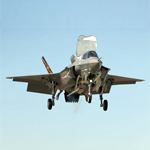Marine Corps Aviation introduces F-35B into fleet

Marine Corps aviation introduced the F-35B Lightning II aircraft into its fleet. The short takeoff vertical landing variant combined with fifth generation capabilities is a breakthrough in itself, matching the importance of the first Marine aviator and starting a new chapter in Marine Corps aviation history. 2nd Marine Aircraft Wing’s Marine Fighter Attack Training Squadron 501 hosted the ceremony inducting the F-35B Lightning II multirole, joint strike fighter, into the Marine Corps aviation arsenal at Eglin Air Force Base, Fla., Feb. 24 at 2 p.m.
Gen. Joseph Dunford, the assistant commandant of the Marine Corps, stated at the rollout ceremony that for the first time in aviation history, the most lethal fighter characteristics came together on a single platform. A list of the aircraft’s abilities include supersonic speed, radar-evading stealth, extreme agility and short takeoff vertical landing capability.
“It’s innovation like that represented here today which has kept Marine aviation ready and relevant for the last 100 years,” said Dunford.
The new aircraft was on display at the VMFAT-501 hangar for military leaders, government officials and other guests to view.
VMFAT-501 will also be the first Marine Corps unit to begin training for and with the F-35B. Eglin has already constructed the F-35 Academic Training Center and in the near future will begin training, throughout all military branches, maintainers and pilots on the aircraft.
“501 is on the forefront of one of the most significant transition periods Marine aviation has ever known,” said Dunford. “Certainly one of the most important in a long time. Maybe since the introduction of the helicopter.”
“We are trying not to waste the time we’ve been given,” said Col. Arthur Tomassetti, the vice commander of the 33rd Fighter Wing, which is responsible for pilot and maintainer training on the F-35 A, B and C models. “We hope that people will be pleased and proud to see the time we’ve been given to prepare operational readiness has been used to the advantage.”